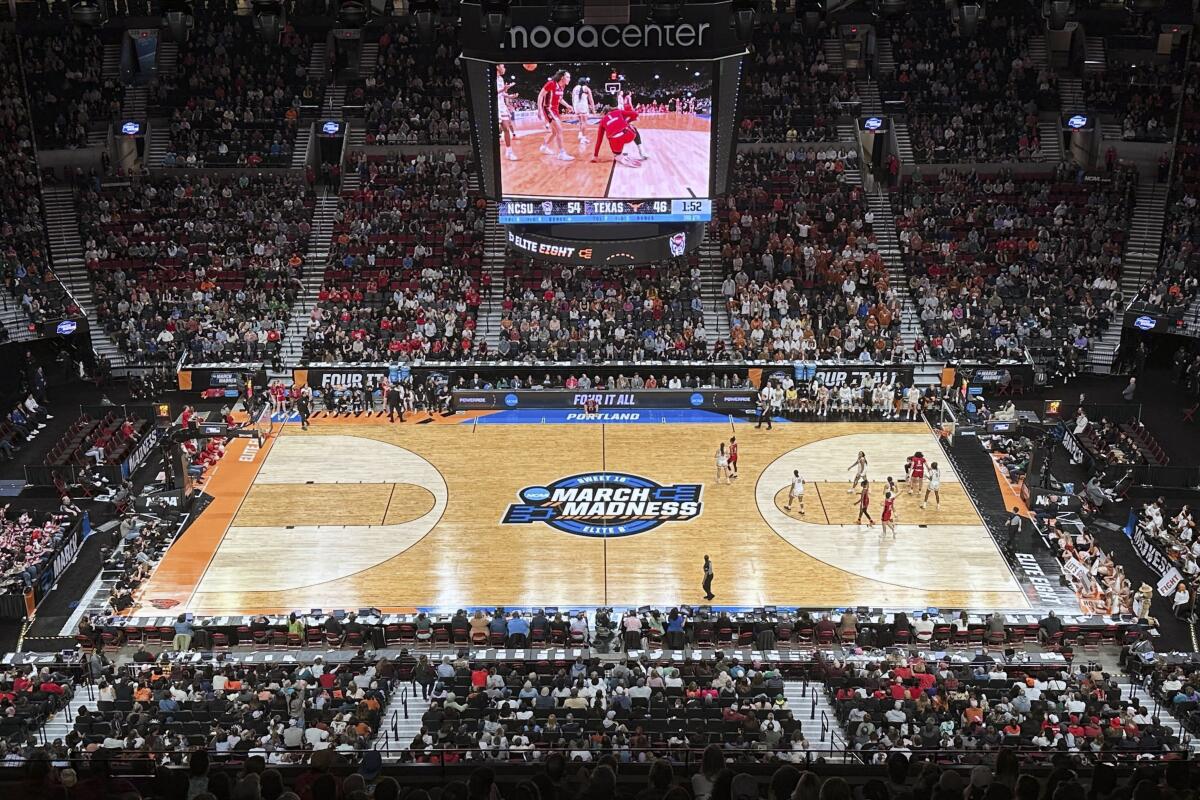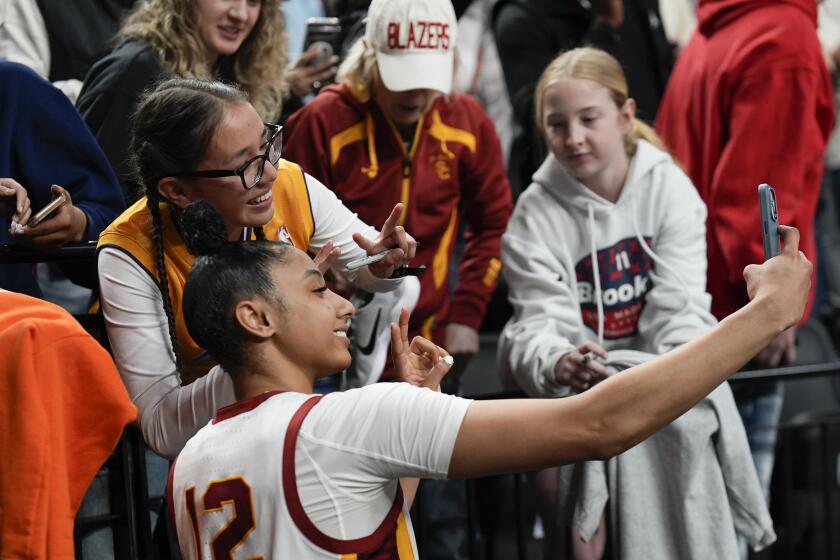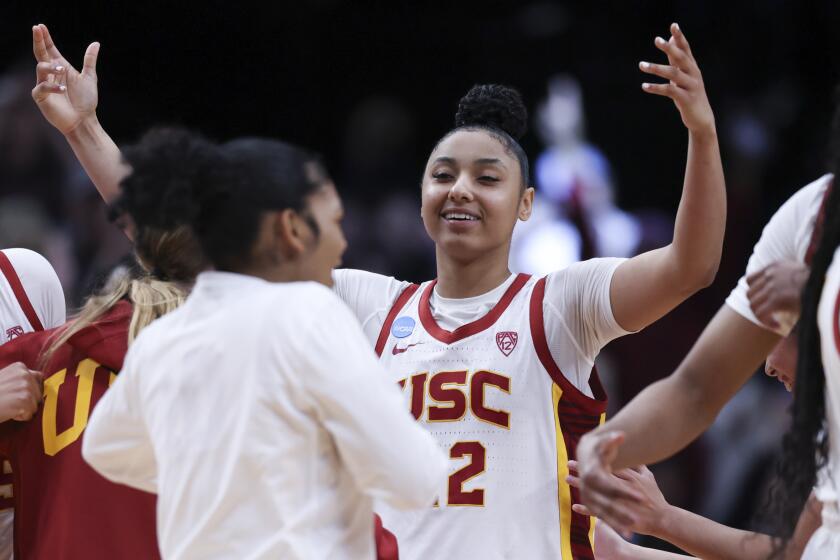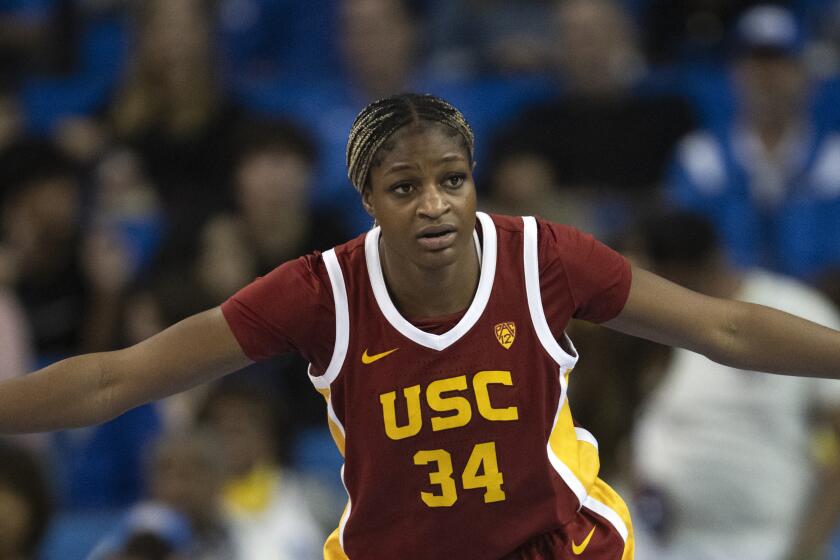Three-point lines will be properly marked for USC-Connecticut — unlike last five NCAA games in Portland

- Share via
When USC and Connecticut play Monday night for a spot in the NCAA women’s basketball Final Four, the three-point lines will be the same distance from the basket on both ends of the court at Moda Center in Portland, Ore.
Makes sense, right? Most people probably assume that’s the case for every game.
But it was not the case during USC’s and Connecticut’s NCAA women’s basketball tournament Sweet 16 games Saturday at the same court. Nor was it the case during the other three tournament games played this weekend, including North Carolina State’s 76-66 win over Texas on Sunday to advance to the Final Four.
Instead, one three-point line was approximately 9 inches closer to the basket than the other, the NCAA said Monday in a statement.
In an earlier statement, issued Sunday after the N.C. State-Texas game, the NCAA said it had been notified of the situation prior to that contest. Both coaches were alerted to the situation at the time.
Coach Geno Auriemma has guided Connecticut to 11 national titles since USC last made the Elite Eight. They meet Monday for the first time in NCAA tourney.
“All parties elected to play a complete game on the court as is, rather than correcting the court and delaying the game,” NCAA vice president of women’s basketball Lynn Holzman wrote in a statement released after the game Sunday.
Connor Sports, the vendor who made the floors for the NCAA men’s and women’s tournaments, issued an apology for the error Sunday.
JuJu Watkins scored 30 points, McKenzie Forbes had 14 and Rayah Marshall had 11 points and 16 rebounds as the top-seeded Trojans held off fifth-seeded Baylor 74-70.
The NCAA said Monday that after the previous day’s games and practices at the venue, it was determined that a marker was placed in the incorrect location under one of the baskets, which led to faulty placement of the three-point arc on that end of the floor.
“The NCAA found the inaccurate line was the result of human error by the finisher contracted by Connor Sports,” the NCCA stated.
The three-point line for NCAA men’s and women’s games is at 22 feet, 1 3/4 inches.
The incorrect arc was covered by paint overnight and replaced by an accurate one in time for Monday’s game, the NCAA said in its most recent statement. The NCAA also verified that the other courts used previously during the men’s and women’s basketball courts were accurately marked and that the ones prepared for next weekend’s Final Four games are correct as well.
In the four Sweet 16 and one Elite Eight games played in Portland this weekend, the teams attempting threes on the correctly marked end made 29 of 87 shots (33.3%), compared with 23 of 89 (25.8%) on the closer end. Both teams in each game spent one half shooting at each end.
“Guess that’s why we shot it better in the 2nd half… correct 3 pt distance!!” Baylor coach Nicki Collen tweeted Sunday, a day after her team’s 74-70 loss to USC in a Portland 3 regional semifinal. The Bears made three of 12 three-point attempts in the first half, compared to six of 14 in the second half.
For the season, USC has made 35.6% of its three-point shots, while Connecticut has made 36.3%. Both teams shot below those averages in their Sweet 16 games. The Trojans were 29.4% from three-point range against Baylor, making two of seven attempts in the first half and three of 10 in the second. Connecticut fared even worse from behind the arc during their 53-45 win over Duke, going 0 for 5 from the shorter end in the first half and 3 for 12 at regular distance in the second half.
Following the N.C. State-Texas game, both coaches were asked about the decision to play on the mismarked court.
After a win over Kansas to reach the Sweet 16, USC star JuJu Watkins says 6-foot-6 teammate Clarice Akunwafo can play ‘against any big in the country.’
“I was worried about if our players were going to have to wait an hour to play,” N.C. State coach Wes Moore said. “I like the fact we could jump out there and play the game. And, again, I don’t think it affected the game, the outcome. Both teams played on it for a half.
“If it would have gone to overtime, we might have a complaint. But as it was, it was equal for both teams.”
Texas coach Vic Schaefer said: “At the end of the day, we had already played a game on it. We both won. So we just decided to play.”
More to Read
Go beyond the scoreboard
Get the latest on L.A.'s teams in the daily Sports Report newsletter.
You may occasionally receive promotional content from the Los Angeles Times.














